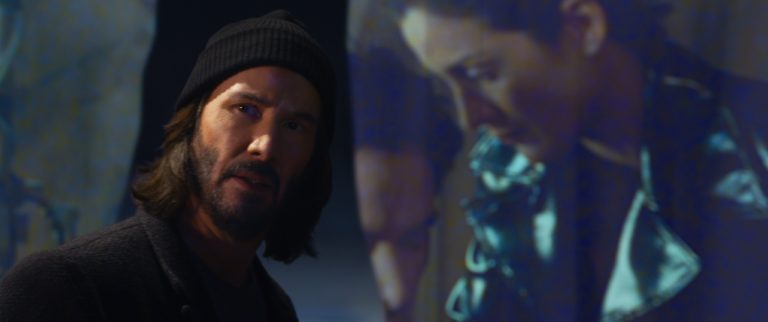The Matrix Resurrections (2021 | USA | 148 minutes | Lana Wachowski)
The Matrix Resurrections makes subtext text right from the jump. Lana Wachowski embraces the meta of this new sequel and makes her new film explicitly about the despair of resurrecting the corpse of seemingly long-dead ideas to appease the hunger of a new generation of content producers and consumers. Whether it’s a sneaky scream from deep within an intellectual prison, a rousing successful return to form, or merely an well-intentioned but clumsily realized impulse to revisit old themes is likely to vary substantially by audience expectations and sympathies (or lack thereof). Some may rejoice to follow her and some familiar characters down the rabbit hole once again. Others, like me, may find themselves desperate to eject.
The film opens with some Matrixy shit, dropping us right back into those old tech-goth vibes: mysterious green symbols streaming across a jet black screen to give a jolt of that 2000s-era magic as they resolve into images of leather-clad hackers in dark rooms wearing creatively bad sunglasses. The interlopers have illicitly injected themselves into the background of what they expect to be a familiar scene: a Trinity-lookalike’s legendary escape from an interrogation by heavily armed captors (“where it all began”). When it goes sideways, they’re baffled about how this high-tech home movie found a life of its own and drew them into the violent action and heavily armed assault. The blue-haired hacker (Bugs, Jessica Henwick) escapes, makes an awe-struck acquaintance with a sentient algorithm, and finds common ground when they realize their paths have converged in the abandoned bedroom of one Thomas Anderson.
Technobabble ensues … Mister Anderson is not home and we soon find out why with a sharp cut to Keanu Reeves, older, bearded, in tech-exec business fashion seemingly watching this action play out on one of his multiple monitors in a modern high-rise office. He’s firmly in grown-up Thomas Anderson mode, no longer Neo. Grizzled Keanu is puzzled that his AI characters have improbably escaped an AI training loop, but an underling interrupts his reverie before he has time to investigate the anomaly. His space is decorated with accolades from a long career as the celebrated chief video game designer for a firm who made a trilogy of award-winning Matrix video games. It’s a clever conceit. In this reality, the epic struggle to escape a simulation run by oppressive robot overlords was a massively-successful genre-breaking series of interactive games. The movies that we saw were essentially a twitch stream of someone beating the game on a single run.
Yet even in this world, Thomas is a bit adrift. He’s the king designer, but is still tethered to his longtime business partner (Jonathan Groff) who’s far too shiny, in slick slim-fitting suits, sockless, and attentive to the matters of money vs. creativity when it comes to the firm’s operations. The meta-ribbing goes further when he insists that Anderson “return to the Matrix” despite his pledge never to do so as a way of appeasing their profit-hungry corporate overlord, Warner Brothers. [From my limited understanding, this is also the exact plot of Space Jam 2, please don’t disabuse me of that belief.] As the company fires up the reboot engines we get long montages of coders brainstorming questions of “what made the Matrix great?” and spinning nonsensical responses that range from fanboy, academic, cultural, and overly-philosohpical. It feels like Lana specifically dunking on decades of message board culture. Which, good for her. It’s been twenty years, take your shot at the nerds who loved your famous thing!
Outside of work, the film introduces another newcomer in the form of a psychotherapist / analyst (Neil Patrick Harris) whose office just happens to have a familiar-looking black cat named Deja Vu (subtle, these are not). Here, we learn about the toll that the previous games took on Anderson’s life. In creating them, he lost sight of reality, came to believe that he was living in a simulation, suffered from hallucinations, and survived a suicide attempt in which he attempted to fly from the roof of a skyscraper. Since then, he’s adopted a range of behavioral coping strategies and a heavy regimen of psychopharmaceuticals (that just happen to be shiny blue pills, again, not nuanced). Harris plays the role as firm but caring, with maybe just a few undercurrents of assertive control, and it’s easy to believe that the two have had a valuable long-term therapeutic relationship.
At the coffee shop near his office (“Simulatte” which actually sounds dumb enough to be authentic), he spots Carrie Anne Moss ordering a beverage from across the room. It’s clear that she’s familiar to him, but he’s never made a move. His colleague notices his reaction and forces an awkward introduction. Her name’s Tiffany, she’s a mother of two, married to a handsome Chad (subtle again), and, though there’s a spark between them, it seems that they’ve never met. We get the sense that he’s been obsessed with her for quite some time. Seeing them together again, older but still looking great, is truly wonderful. For a minute, I dreamed that the whole movie would go on like this. Audiences hoping for a techno-action thriller would be trolled and the whole film would be the two of these actors sharing cortados, getting reacquainted over shared memories of that long strange trip that they shared in their youths, maybe falling in love, maybe not. I’d watch that film a hundred times, no matter how many blue pills I had to swallow.
But alas, ‘twas a futile fantasy. As he gets back into the thick of rebooting the Matrix video game franchise, Thomas Anderson’s again begins to question the ol’ nature of his reality. There’s a pretty great montage of his disintegrating sanity set to Jefferson Airplane’s “White Rabbit” that’ll be familiar to anyone who already obsessed over the trailer. As his hold on his sanity begins to fracture, increasingly unsettling and violent hallucinations motivate emergency sessions with his therapist. There, Keanu makes the most of excellent deadpan opportunities with stark self-appraisals lines like, “Either I’m having a mental breakdown (again) or I’m imprisoned in a computer simulation (again)”. It’s a cheese ball line, but no one can sell preponderous line readings quite like he can.
Eventually, of course, the movie grinds into being Matrixy again. The corpse of old IP is re-animated and pulled from the gooey chamber of history, often by direct inclusion of footage from the original films. Intended to remind us of where it all started and to comment on the passage of time, the use of these old clips and re-creation of old scenes mostly made me sad. The story makes a reason for the rehashes, but they’re somehow more poorly realized this fourth time around. Whereas the original films were groundbreaking in technique and approach, this retread looks considerably cheaper, less inspired, and more shoddily executed across the board. Action sequences are bland re-treads, the fight choreography is surprisingly inelegant, and the visual effects seem hastily compiled on a highly-constrained budget and with far less attention to detail.
Amid my disappointment, I could still applaud Wachowski’s motivations to maintain ownership of the ideas of her franchise and explore themes of aging, what it means to have a body, the ramifications of changing physical appearance as well as the persistent question of the paradox of choice. But it’s all in such a ponderous package that the ideas never sprung to life (for me). We catch up with a few familiar characters who communicate how the world has changed, alliances have shifted, and revolutionary goals have evolved. With all of the attention to the past, there’s not much room for new characters to develop; so it’s hard to invest in blue-haired true believer Bugs (she also has a white rabbit tattoo, so again with the heavy-handedness) or a rebooted version of Morpheus (Yahya Abdul-Mateen II) who now exists in a new hybrid form and appearance because of [reasons].
As the scale gets grander and the stakes get higher, I again found myself desperate to wash down some shiny blue pills with my Coke Zero to bring it to an end. The dragging pace is made literal when the major use for the once revolutionary technique of slowing down time is used not for spectacular fight sequences, but instead to allow the principal antagonist to stretch already ponderous and cliche-laden speeches (yes, multiple) to even more egregious lengths. There’s an extent to which this film inadvertently communicates the agony of being trapped in a prison of someone else’s making, but it takes too great a leap of the imagination to believe this was the intent. As great as it was to see the older, wiser, and somehow more charismatic versions of Reeves and Moss in a Wachowski playground, I found myself among the contingent who would’ve taken the red pill and immediately regretted it.
Note: Chase and I both went into this last big prestige blockbuster of the year with pretty high hopes; one of us left elated and the other was desperate to leave. Check out his take here.
The Matrix Revolutions arrives in theaters or can be jacked directly into your brain via HBO Max beginning on December 22nd.




